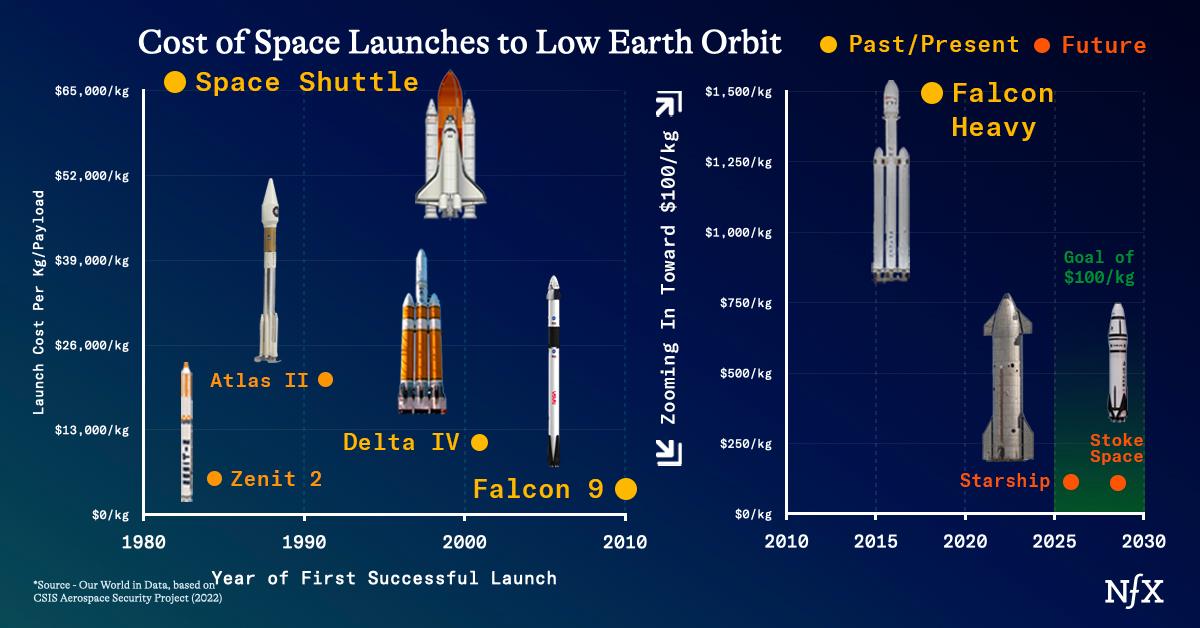Is investing in, let alone founding, a launch company completely insane?
Yes.
And…
We strongly believe that space is the next frontier. The space economy is a massive economic opportunity, and launch companies will be the rent collectors of that economy.
Yes there is SpaceX, but maybe surprisingly, there are massive second mover advantages as well. Ultimately, if we want to capture the trillions that can be generated in space by 2035, we (humanity) are going to need more than one launch supplier.
For transparency: We are investors in Stoke Space. So is this confirmation bias? Maybe yes. And…
Once you see the industry from their perspective, it’ll change things for you. It did for us.
Launch Is Rent
More and more capital is being invested into the “space economy.” By some estimates, VCs have invested close to $9B in space companies this year alone.
The biggest line item (most likely) on each of these company’s expense sheets is launch. Any time any company wants to get to space, they have to pay that cost. It’s rent.
Let’s take satellites as a case study – they’re not the only things we launch into space, but they do make up significant portions of the demand for launch. In conservative scenarios, there will be 4x more satellites in orbit in 2030 than there are today. And, there are already plans for massive constellations of satellites in the future, like Starlink, Amazon Kuiper, and OneWeb to start.
To meet those goals, satellites need a way to get to where they need to go (more launches).
This means we’re headed for an undersupply of launch in the short run. Even with SpaceX’s Starship, which could do a lot to close that gap, we know that the demand for launch is only going to increase – and probably more than people think.
In the long term, demand might asymptote. But even when that point arrives, the major players are going to be locked in, and still collecting rent. They’re going to be the landlords of an industry with a value on par with the semi conductor space today.
And even despite that, starting a launch company is still insane. Unless you can solve the biggest problem in the industry: 100% reusability.
The State of The Launch Market
When I bring up this general topic, the obvious next question I get is:
Isn’t all this money going to flow right to SpaceX?
Well, not all the money. But it’s a fair question.
Back in 2018, SpaceX massively disrupted the cost of launch by developing Falcon Heavy. That partially reusable rocket reduced launch costs to about $1,500 per kg, a record-low at the time.
Despite that being fucking awesome, SpaceX didn’t really finish the job. At least not yet.
The partially reusable rocket is only a stopgap measure. That second stage still burns to a crisp upon return to earth (called a “deorbit burn”). Put differently: you have to throw away a large part of a very expensive thing every time you go to space. To launch again, you need to pay for, let alone build, another very expensive thing.
This is why the cost of launch today is still prohibitive for many companies, let alone ideas that can’t even become companies because of this hurdle.


The real problem facing launch startups (and the space industry at large) is complete reusability. Complete reusability opens the door to lower production costs, higher launch frequency, and more specific travel.
If we can achieve that, the whole pie will get bigger. Lower transportation costs are a precursor to innovation, and that often creates markets that were inconceivable before. Tall ships accelerated the exchange of goods and ideas. The Model T led to the development of the suburbs…
SpaceX knows this. Anyone who actually cares about the space economy knows this. This is why everyone watches Starship launches so carefully –– it’s a very real path to breaking a key economic milestone ~ $100/kg to low earth orbit.
If we can get there (or lower), everyone knows that company creation in space will go exponential.
SpaceX is far from the only company working on this problem (enter Stoke, more on this later). And until they solve “it”…there will always be room in the industry for someone who does solve it.
So when people ask me: Isn’t this SpaceX’s game to lose? I suggest reframing it. It’s a race to solve the key engineering problem that will open up economies of scale for launch. (And there’s room for more than one winner).
That’s the first part of the answer.
The second part of the answer is that there’s still room to innovate on quality of launch – not just price.
SpaceX is basically the only option for space companies right now. And it’s not perfect.
-
- It’s expensive (sure, SpaceX can cut prices. But why do that if you’re the biggest player?)
- It’s, effectively, public transit*
*Let me explain. SpaceX books a mission to a specific point in a specific orbit on a specific date. That may be where you have to go, or it may be very far from where you have to go. Either way, that’s the only option. Hop on board, or tough luck.
Now let’s say it’s nowhere near where you have to go. Fine. In that case, you have to hire a space tug company (like a shuttle bus) to get you there. This increases both direct and indirect costs, in addition to increasing risk.
This whole situation is not ideal but, it’s a kind of c’est la vie dynamic –– there’s nothing else.
But what if there was something else? Ideally, an “UberX” for space exists that is more door-to-door service. This would be a layup for the right company.
(And yes, this is exactly what Stoke is trying to do).
For the right founder, this was a huge opportunity. SpaceX solved a major part of the problem (getting to space in the first place, making a partially reusable rocket). But they haven’t solved the absolutely critical part that will allow the space economy to reach its full potential.
This gap leaves room for a handful of major launch companies to get in the game. And we need more launch companies to get in the game. At the moment, we have more launch demand than we have supply. We have a clear engineering problem that’s holding back a massive market. It’s time to move.
(And again, we’re investors in one of them: Stoke Space. Now that the lede has sufficiently been buried, here we go.).
Case Study: Stoke Space
When Andy Lapsa and Tom Feldman founded Stoke Space it was absolutely insane to start a launch company. Maybe even more insane than it was when Elon Musk started SpaceX.
Elon had to resurrect a flailing American launch industry (and compete with Jeff). Andy had to compete with(Elon, and Jeff, and Rocket Lab, and Relativity…). That’s in addition to the fact that starting a launch company is a bit of an insane thing to do, in general.
But, from their perspectives as engineers, Andy and Tom saw the gaping hole in the industry: full reusability. No one had figured out how to stop the second stage of most rockets from burning up as they re-entered Earth’s atmosphere.
To them, it wasn’t worth starting a company at all if they couldn’t solve the full reusability problem. We agree(d).
Andy and Tom had an idea of how to do it. Stoke’s second stage uses cryogenic hydrogen as fuel for propulsion, as well as coolant during atmospheric reentry. As the second stage descends through the atmosphere, liquid hydrogen flows through the heat shield, absorbing and carrying away reentry heat.
Forgive the extremely simplified version of what has proven to be a unique perspective in rocket design. But the fact that the thought process is just that –simple in theory, but complex in execution – is what makes a truly disruptive idea.
(And if you’re interested/want more, Everyday Astronaut’s overview of the company is worth a watch.)
The idea was so obvious to Tom and Andy that they quit their jobs to find a company using this approach. “It” (this design) was so obvious to them that they assumed that somebody had started a company out there with this approach. They were shocked to find that no one had.
When we were first doing due diligence on Stoke, I spoke to an expert who compared this realization to the invention of the airplane. Back in the day, there were many attempts at building “flying machines” and no one could figure it out. People were using existing mental models: take a heavy thing, fly it in a straight line. Most of those airplane designs ended up in the Potomac.
And then…Two bicycle mechanics from Ohio brought a different mental model (what if we mimic birds?) and figured it out. The Wright brothers solved a key engineering problem (three axis control, if you’re interested), that allowed them to maintain equilibrium and steer the plane.
That was the difference between flying, and crashing.
Andy and Tom aren’t exactly bicycle mechanics from Ohio. They’re trained engineers, with deep expertise. But it was their ability to identify a key problem from a different perspective, and even more importantly, actually solve it, that makes them stand out.
Ultimately, by solving the re-entry and reusability problem, Stoke is in a position to carve out market share from SpaceX and take the brakes off the space economy.
I’m telling this story mostly to drive home the fact that founders in this sector are goddamn studs. They’re a huge reason we’re excited about space in the first place. People like Andy and Tom.
They’re capturing opportunity in a market with one of the biggest incumbent players in the game, in one of the most difficult industries, faster than some companies can build software.
Launch Now -> Locked In
Even the most brilliant team is not going to have money, resources, time, or justification to reinvent a launch system if there are already great systems in place.
Once we solve reusability, launch is an impermeable defensibility.
If anything, companies that own launch are more likely to expand beyond launch. For them, the most expensive item on the budget is essentially free. They have intimate knowledge of what works and doesn’t work in space. Once they carve out their piece of launch, it’ll be far easier to become providers of space-related services: servicing satellites, tourism, software, communications.
Just look at the symbiotic relationship between SpaceX’s launch capacity and Starlink for example. They’re owning both the transportation and use case.
If you own launch, it’s a springboard.
Ultimately, there are going to be a handful of companies that operate like Amazon Prime in space.
It’s already happening.
We’re all in on launch, and on the companies that reusable launch is about to enable.
If you’re one of those companies: talk to us.
As Founders ourselves, we respect your time. That’s why we built BriefLink, a new software tool that minimizes the upfront time of getting the VC meeting. Simply tell us about your company in 9 easy questions, and you’ll hear from us if it’s a fit.



